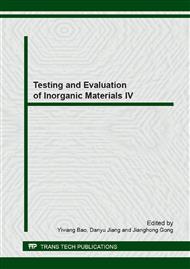p.232
p.236
p.240
p.245
p.249
p.253
p.258
p.263
p.267
The Influence of ZnO Sintering Aid on Properties of BaZr1-xYxO3-δ Proton-Conducting Electrolyte
Abstract:
The influence of ZnO sintering aid on the structure, morphology and electrical properties of BaZr1-xYxO3-δ proton-conducting electrolyte is presented. XRD showed that all the samples mainly consisted of single-phase cubic perovskite structure. Except for BaZrO3+ 1wt% ZnO, other samples show a peak arising from a small amount of Y2O3 impurity. SEM analysis showed that all the materials have a very dense structure after being sintered at 1300 oC with ZnO sintering aid. For densified BaZr1-xYxO3-δ+ 1wt% ZnO system the ZnO addition did not lead to increase the grain size. The change of the crystal structure of BaZr1-xYxO3-δ + 1wt% ZnO system with the content of doped yttrium was investigated. The lattice parameter and unit cell volume increased sharply at x<0.2, but it was maximal and almost constant at x≥0.2. The impedance spectra for BaZr0.8Y0.2O3-δ + 1wt% ZnO sample at three different temperatures were compared. With increasing temperature the resistance for mass transfer at the electrolyte-electrode interface was reduced markedly compared to that of the grain boundary.
Info:
Periodical:
Pages:
249-252
Citation:
Online since:
November 2013
Authors:
Price:
Сopyright:
© 2014 Trans Tech Publications Ltd. All Rights Reserved
Share:
Citation:


